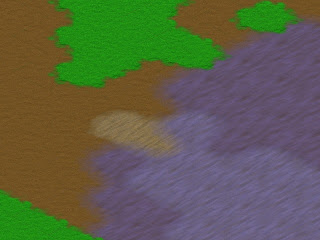
The switch to isometric, engine-wise, is as simple as changing a camera setting. There are some minor complications with texture filtering, easily solved by rearranging the way the assets are stored, not a big deal. I am considering doing the submaps in isometric. They are where all the action takes place, and things aren't as weird as a top down.
It's either that, or switch the story and setting of the game itself to one that favors a top down perspective more. The biggest gripe I have is that humanoid figures are so hard to distinguish in top down, since most of the distinguishing features are hidden. However, if I were to switch to focus on a different set of races/civilizations/whatever rather than humanoid, I could pull off the top-down much more stylishly.
Awhile back I had the idea for a game called Drone, wherein you play a drone member of a hive of genetically altered insects. You advance in rank within the hive, and correspondingly advance in power and self-mastery until you could at last break away from the hive mind and start your own hive.
The thing I like about insects is that they look good from top-down, and are easily distinguishable from one another. The thing I don't like about insects is that making graphics for their hives and nests is very difficult for me. All the dripping ichor and ooze, all the gristly legs and antenna, etc... I don't do so well with that sort of thing. My dripping ichor tends to look like grey blobbish things, and not ichor at all. Also, so far I've held somewhat to the old-school RPG look and feel (mountains/forest/grass/water, fantasy-setting type stuff), and I'm not sure how well it would jive with the whole insect thing.
I could always resurrect my old Golem story. Many years back I was working on an isometric game called Golem, wherein you play the part of a magical construct working to save the last remnant of the human race from extinction by other golems running wild. The beauty of that idea was that the constructs were often bizarre, and typically not humanoid in nature. Many of the golems I conceptualized would work as well in top-down as in isometric.
At any rate, I have begun work on the 'action' parts of the game. To crudely paraphrase Gamasutra's post-mortem on Diablo 2, I need to get a guy moving around on the screen and hacking at monsters. Whether in top-down or isometric, monster hacking is monster hacking.










